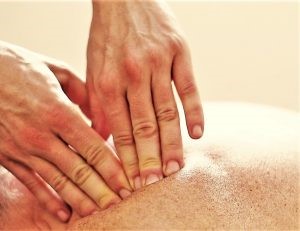
Sartorius Muscle – the honeymoon muscle
February 19, 2022To understand this work it’s important to define a trigger point. A Trigger Point is a hyper-irritable spot in muscle tissue that is an area of maximum tenderness. When compressed it may give rise to referred pain and tenderness somewhere else in the body. Usually these points are located at the attachment sites or in the belly of a muscle. Trigger Points arise from many different perpetuating factors in which include poor posture, structural imbalances, repetitive muscle use, poor sleeping habits, lack of hydration, poor nutrition, and an inactive lifestyle. All these things add up to a dysfunctional muscle that is chronically tight and taut, shortened and unable to relax. Clinical Trigger Point Massage is all about releasing these points of tenderness. Trigger Points are released through short strokes, compression, then stretching the muscle tissue to restore normal range of motion.
Debby, a Trigger Point practitioner is skilled to know the needed amount of pressure to alleviate the trigger point while staying within the client’s tolerance level. This treatment should never feel uncomfortable but it’s important to go beyond the pain level in order to reach the deeper layers of muscle usually where the problem lies. We’ll ask clients for feedback to when they’ve meet their threshold or when they are uncomfortable at the pressure. We do not believe in “no pain no gain” concept. We’ll apply pressure in a particular direction then change the angle of the thumb and slowly begin to increase compression until you again reach the pain threshold. The palpatory assessment provides the clients an understanding of muscle anatomy and kinesiology.
Perpetuating factors causes and keeps TrPs going. TrP practitioners will not only clear the area of pain but also help you to understand the underlying cause. She’ll ook at the perpetuating factors which is usually neglected or dismissed as unimportant and she’ll offer suggestions to eliminate or modify the activity causing it.
In health care today many patients endure needless pain and medical tests due to lack of recognition and treatment of Trigger Points. Yet, patients get better when their trigger points are treated. Signs of distressing ubiquitous muscle ache and pains are usually overlooked and misunderstood source of myofascial trigger points. Understanding Trigger Points and their perpetuating factors can give you some measure of control over symptoms and if treated properly, the symptom will go away.




